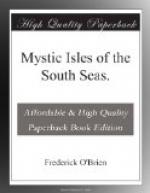The broad avenue lessened into a broken road, roofed by many kinds of trees. Though the sun ascended from the ocean on the other side of Tahiti above the fantastic peak of Maiauo, it had not shed a beam upon the ferns and mosses. The guava was a dense growth. Like the lantana of Hawaii and Ceylon, imported to Tahiti to fill a want, it had abused hospitality, and become a nuisance without apparent remedy. How often man works but in circles! Everywhere in the world plants and insects, birds and animals, had been pointed out to me that had been acquired for a beneficent purpose, and had become a curse.
The mina-bird was brought to Tahiti from the Moluccas to eat wasps which came from South America, and were called Jack Spaniards. The mina, perhaps, ate the insects, but he also ate everything else, including fruit. He stole bread and butter off tables, and his hoarse croak or defiant rattle was an oft-repeated warning to defend one’s food. The minas were many in Tahiti, and, like the English sparrow in American cities and towns, had driven almost all other birds to flight or local extinction. The sparrow’s urban doom might be read in the increasing number of automobiles, but the mina in Tahiti, as in Hawaii, had a sinecure.
Noanoa Tiare said that the guava had its merits. Horses and cattle ate its leaves and fruit, and the wood was a common fuel throughout Tahiti. The fruit was delicious, and in America or England would be all used for jelly, but only Lovaina preserved it. The passion-flowers of the granadilla vines, white and star-like, with purpling centers, were intermingled with the guavas, a brilliant and aromatic show, the fruit like miniature golden pumpkins. Their acid, sweetish pulp contained many seeds, each incased in white jelly. One ate the seeds only, though the pulp, when cooked, was palatable.
The road dwindled into a narrower path, and then a mere trail. The road had crossed the brook many times on frail bridges, some tottering and others only remnants. Habitations ceased, and we were in a dark, splendid gorge, narrow, and affording one no vision straight ahead except at intervals.
The princess named many of the growths we passed, and explained their qualities. The native is very close to the ground. The lantana, with its yellow and magenta flowerets, umbrella ferns, and aihere, the herbe de vache, and the bohenia, used by the Tahitians for an eye lotion, were all about. Palms, with cocoanuts of a half dozen stages of growth, and giant banana-plants lined the banks, and bushes with blue flowers like violets, and one with red buttons, intermingled with limes and oranges to form a thicket through which we could hardly force our way.
We were yet on the level of the rivulet, but now, the princess said, must take to the cliff. We had come to a pool which in symmetry and depth, in coolness and invitingness, outranked all before. I was very hot, the beads of perspiration like those in a steamroom.




